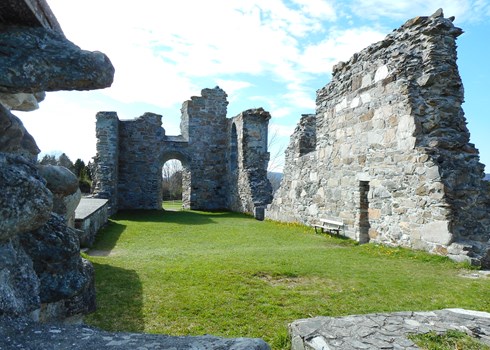

Owned by the National Trust of Norway since 1846.
The remains of the monastery church still stand. The only part of the monastery complex to survive is the remains of the monastery church. In its day, the church was an imposing building with an external length of about 33.5 meters and a width of 10.5 metres, and it is assumed to have had a ridge height of approximately 14 metres. There were no vaults in the church, so the roof trusses were exposed, and the many windows must have given the church a light and airy feel. The preserved part of the western gable wall is 12 metres high and shows that this was a stately Gothic-style church. Munkeby monastery in Levanger, which is also owned by the National Trust of Norway, preceded Tautra monastery in this region. The monastery complex comprised several more buildings, probably made from wood, on the southern side of the monastery church.
Skilful monks left their mark. The Cistercian monks were known for being skilled in agriculture and horticulture, and the local flora at Tautra still shows traces of their skill. Old records show that the monastery engaged in fishing in the fjord, which was rich in fish, and ran a farm with many animals. The climate was well suited for farming. Records of the food stores show that the monks lived well. Information also exists that documents extensive trade, as the monastery sold its surplus produce. The complex went from being a wealthy monastery whose abbots were held in high esteem to becoming severely reduced and dilapidated. The monastery was shut down in 1537 when all monasteries in Denmark-Norway were dissolved in connection with the Reformation.
Things to do in the area. Tautra is a lush island located in Trondheimsfjord in the Frosta municipality. The island is a wetland nature reserve and residence to a rich and active bird life. Nearby to Tautra Monastery lies Klostergården with overnight and dining accommodations. You can also find the Mary Monastery on the island.Frosta is a peninsula in the Trondheimsfjord with a beautiful cultural landscape rich in history and things to do. The area offers great opportunities for walking and cycling, fishing and outdoor pursuits. The site of the Frostating assembly, Frostatinget, with memorial stones, is in the area, as is Logtun church, which is also one of the National Trust's properties and much, much more.
The National Trust of Norway’s many properties in this part of Trøndelag are also well worth a visit: Reinskloster, Munkeby monastery, Steinvikholm castle, Logtun church, Hustad church, Sakshaug old church and the Saint Olav monument at Stiklestad.
Sources: En reise gjennom norsk byggekunst, ed. Terje Forseth. National Trust of Norway, 1994. Øystein Ekroll 2003: Munkeby-Tautra. Cisterciencernes klosterruiner i Trøndelag. National Trust of Norway, Trøndelag branch. Klosteranlegg i Norge. En oversikt. National Trust of Norway, issue 68, 1987
Opening hours
- The ruin is an open outdoor destination, free to visit.
- Guided tours for groups by appointment thorugh Visit Frosta. See contact information
Ticket prices
Visit us
Klostergårdsvegen7633 Tautra
Contact us
- Tlf: 404 36 345
- Epost: info@visitfrosta.no


